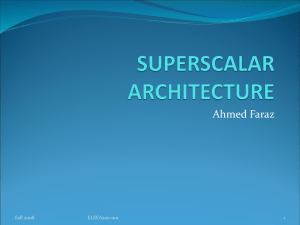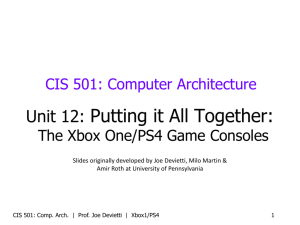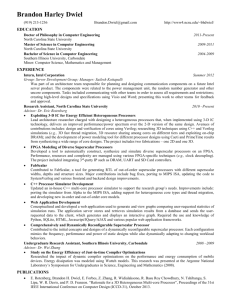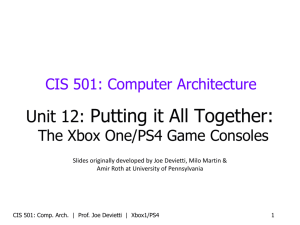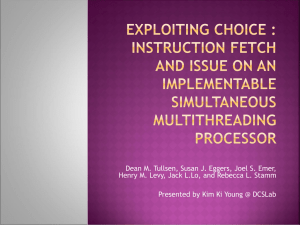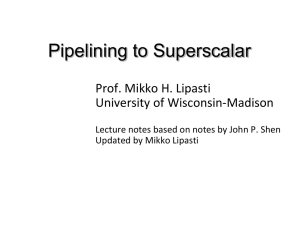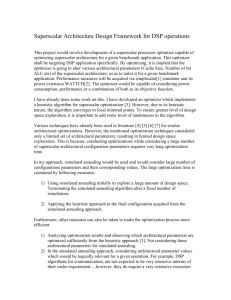Superscalar
advertisement
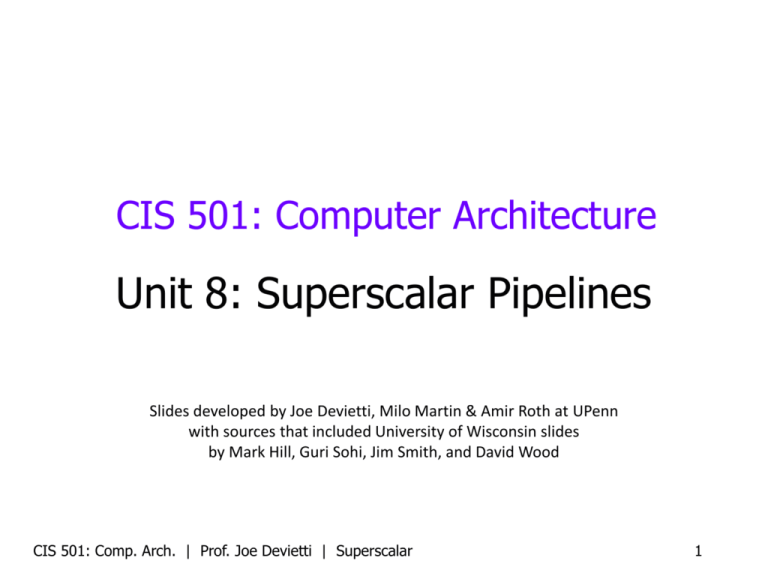
CIS 501: Computer Architecture Unit 8: Superscalar Pipelines Slides developed by Joe Devietti, Milo Martin & Amir Roth at UPenn with sources that included University of Wisconsin slides by Mark Hill, Guri Sohi, Jim Smith, and David Wood CIS 501: Comp. Arch. | Prof. Joe Devietti | Superscalar 1 A Key Theme: Parallelism • Previously: pipeline-level parallelism • Work on execute of one instruction in parallel with decode of next • Next: instruction-level parallelism (ILP) • Execute multiple independent instructions fully in parallel • Then: • Static & dynamic scheduling • Extract much more ILP • Data-level parallelism (DLP) • Single-instruction, multiple data (one insn., four 64-bit adds) • Thread-level parallelism (TLP) • Multiple software threads running on multiple cores CIS 501: Comp. Arch. | Prof. Joe Devietti | Superscalar 2 This Unit: (In-Order) Superscalar Pipelines App App App • Idea of instruction-level parallelism System software Mem CPU I/O • Superscalar hardware issues • Bypassing and register file • Stall logic • Fetch • “Superscalar” vs VLIW/EPIC CIS 501: Comp. Arch. | Prof. Joe Devietti | Superscalar 3 Readings • Textbook (MA:FSPTCM) • Sections 3.1, 3.2 (but not “Sidebar” in 3.2), 3.5.1 • Sections 4.2, 4.3, 5.3.3 CIS 501: Comp. Arch. | Prof. Joe Devietti | Superscalar 4 “Scalar” Pipeline & the Flynn Bottleneck regfile I$ D$ B P • So far we have looked at scalar pipelines • One instruction per stage • With control speculation, bypassing, etc. – Performance limit (aka “Flynn Bottleneck”) is CPI = IPC = 1 – Limit is never even achieved (hazards) – Diminishing returns from “super-pipelining” (hazards + overhead) CIS 501: Comp. Arch. | Prof. Joe Devietti | Superscalar 5 An Opportunity… • But consider: ADD r1, r2 -> r3 ADD r4, r5 -> r6 • Why not execute them at the same time? (We can!) • What about: ADD r1, r2 -> r3 ADD r4, r3 -> r6 • In this case, dependences prevent parallel execution • What about three instructions at a time? • Or four instructions at a time? CIS 501: Comp. Arch. | Prof. Joe Devietti | Superscalar 6 What Checking Is Required? • For two instructions: 2 checks ADD src11, src21 -> dest1 ADD src12, src22 -> dest2 (2 checks) • For three instructions: 6 checks ADD src11, src21 -> dest1 ADD src12, src22 -> dest2 ADD src13, src23 -> dest3 (2 checks) (4 checks) • For four instructions: 12 checks ADD ADD ADD ADD src11, src12, src13, src14, src21 src22 src23 src24 -> -> -> -> dest1 dest2 dest3 dest4 (2 checks) (4 checks) (6 checks) • Plus checking for load-to-use stalls from prior n loads CIS 501: Comp. Arch. | Prof. Joe Devietti | Superscalar 7 What Checking Is Required? • For two instructions: 2 checks ADD src11, src21 -> dest1 ADD src12, src22 -> dest2 (2 checks) • For three instructions: 6 checks ADD src11, src21 -> dest1 ADD src12, src22 -> dest2 ADD src13, src23 -> dest3 (2 checks) (4 checks) • For four instructions: 12 checks ADD ADD ADD ADD src11, src12, src13, src14, src21 src22 src23 src24 -> -> -> -> dest1 dest2 dest3 dest4 (2 checks) (4 checks) (6 checks) • Plus checking for load-to-use stalls from prior n loads CIS 501: Comp. Arch. | Prof. Joe Devietti | Superscalar 8 How do we build such “superscalar” hardware? CIS 501: Comp. Arch. | Prof. Joe Devietti | Superscalar 9 Multiple-Issue or “Superscalar” Pipeline regfile I$ D$ B P • Overcome this limit using multiple issue • Also called superscalar • Two instructions per stage at once, or three, or four, or eight… • “Instruction-Level Parallelism (ILP)” [Fisher, IEEE TC’81] • Today, typically “4-wide” (Intel Core i7, AMD Opteron) • Some more (Power5 is 5-issue; Itanium is 6-issue) • Some less (dual-issue is common for simple cores) CIS 501: Comp. Arch. | Prof. Joe Devietti | Superscalar 10 A Typical Dual-Issue Pipeline (1 of 2) regfile I$ D$ B P • Fetch an entire 16B or 32B cache block • 4 to 8 instructions (assuming 4-byte average instruction length) • Predict a single branch per cycle • Parallel decode • Need to check for conflicting instructions • Is output register of I1 is an input register to I2? • Other stalls, too (for example, load-use delay) CIS 501: Comp. Arch. | Prof. Joe Devietti | Superscalar 11 A Typical Dual-Issue Pipeline (2 of 2) regfile I$ D$ B P • Multi-ported register file • Larger area, latency, power, cost, complexity • Multiple execution units • Simple adders are easy, but bypass paths are expensive • Memory unit • Single load per cycle (stall at decode) probably okay for dual issue • Alternative: add a read port to data cache • Larger area, latency, power, cost, complexity CIS 501: Comp. Arch. | Prof. Joe Devietti | Superscalar 12 Superscalar Implementation Challenges CIS 501: Comp. Arch. | Prof. Joe Devietti | Superscalar 13 Superscalar Challenges - Front End • Superscalar instruction fetch • Modest: fetch multiple instructions per cycle • Aggressive: buffer instructions and/or predict multiple branches • Superscalar instruction decode • Replicate decoders • Superscalar instruction issue • Determine when instructions can proceed in parallel • More complex stall logic - O(N2) for N-wide machine • Not all combinations of types of instructions possible • Superscalar register read • Port for each register read (4-wide superscalar 8 read “ports”) • Each port needs its own set of address and data wires • Latency & area #ports2 CIS 501: Comp. Arch. | Prof. Joe Devietti | Superscalar 14 Superscalar Challenges - Back End • Superscalar instruction execution • Replicate arithmetic units (but not all, say, integer divider) • Perhaps multiple cache ports (slower access, higher energy) • Only for 4-wide or larger (why? only ~35% are load/store insn) • Superscalar bypass paths • More possible sources for data values • O(PN2) for N-wide machine with execute pipeline depth P • Superscalar instruction register writeback • One write port per instruction that writes a register • Example, 4-wide superscalar 4 write ports • Fundamental challenge: • Amount of ILP (instruction-level parallelism) in the program • Compiler must schedule code and extract parallelism CIS 501: Comp. Arch. | Prof. Joe Devietti | Superscalar 15 Superscalar Bypass • N2 bypass network versus – – – – (N+1)-input muxes at each ALU input N2 point-to-point connections Routing lengthens wires Heavy capacitive load • And this is just one bypass stage (MX)! • There is also WX bypassing • Even more for deeper pipelines • One of the big problems of superscalar • Why? On the critical path of single-cycle “bypass & execute” loop CIS 501: Comp. Arch. | Prof. Joe Devietti | Superscalar 16 Not All N2 Created Equal • N2 bypass vs. N2 stall logic & dependence cross-check • Which is the bigger problem? • N2 bypass … by far • 64- bit quantities (vs. 5-bit) • Multiple levels (MX, WX) of bypass (vs. 1 level of stall logic) • Must fit in one clock period with ALU (vs. not) • Dependence cross-check not even 2nd biggest N2 problem • Regfile is also an N2 problem (think latency where N is #ports) • And also more serious than cross-check CIS 501: Comp. Arch. | Prof. Joe Devietti | Superscalar 17 Mitigating N2 Bypass & Register File • Clustering: mitigates N2 bypass • Group ALUs into K clusters • Full bypassing within a cluster • Limited bypassing between clusters • With 1 or 2 cycle delay • Can hurt IPC, but faster clock • (N/K) + 1 inputs at each mux • (N/K)2 bypass paths in each cluster • Steering: key to performance • Steer dependent insns to same cluster • Cluster register file, too • Replicate a register file per cluster • All register writes update all replicas • Fewer read ports; only for cluster CIS 501: Comp. Arch. | Prof. Joe Devietti | Superscalar 18 Mitigating N2 RegFile: Clustering++ cluster 0 RF0 cluster 1 RF1 DM • Clustering: split N-wide execution pipeline into K clusters • With centralized register file, 2N read ports and N write ports • Clustered register file: extend clustering to register file • • • • Replicate the register file (one replica per cluster) Register file supplies register operands to just its cluster All register writes go to all register files (keep them in sync) Advantage: fewer read ports per register! • K register files, each with 2N/K read ports and N write ports CIS 501: Comp. Arch. | Prof. Joe Devietti | Superscalar 19 Another Challenge: Superscalar Fetch • What is involved in fetching multiple instructions per cycle? • In same cache block? no problem • 64-byte cache block is 16 instructions (~4 bytes per instruction) • Favors larger block size (independent of hit rate) • What if next instruction is last instruction in a block? • Fetch only one instruction that cycle • Or, some processors may allow fetching from 2 consecutive blocks • What about taken branches? • How many instructions can be fetched on average? • Average number of instructions per taken branch? • Assume: 20% branches, 50% taken ~10 instructions • Consider a 5-instruction loop with an 4-issue processor • Without smarter fetch, ILP is limited to 2.5 (not 4, which is bad) CIS 501: Comp. Arch. | Prof. Joe Devietti | Superscalar 20 Increasing Superscalar Fetch Rate regfile I$ B P insn queue also loop stream detector D$ • Option #1: over-fetch and buffer • Add a queue between fetch and decode (18 entries in Intel Core2) • Compensates for cycles that fetch less than maximum instructions • “decouples” the “front end” (fetch) from the “back end” (execute) • Option #2: “loop stream detector” (Core 2, Core i7) • Put entire loop body into a small cache • Core2: 18 macro-ops, up to four taken branches • Core i7: 28 micro-ops (avoids re-decoding macro-ops!) • Any branch mis-prediction requires normal re-fetch • Other options: next-next-block prediction, “trace cache” CIS 501: Comp. Arch. | Prof. Joe Devietti | Superscalar 21 Multiple-Issue Implementations • Statically-scheduled (in-order) superscalar • + – • What we’ve talked about thus far Executes unmodified sequential programs Hardware must figure out what can be done in parallel E.g., Pentium (2-wide), UltraSPARC (4-wide), Alpha 21164 (4-wide) • Very Long Instruction Word (VLIW) + • • Compiler identifies independent instructions, new ISA Hardware can be simple and perhaps lower power E.g., TransMeta Crusoe (4-wide) Variant: Explicitly Parallel Instruction Computing (EPIC) • A bit more flexible encoding & some hardware to help compiler • E.g., Intel Itanium (6-wide) • Dynamically-scheduled superscalar (next topic) • Hardware extracts more ILP by on-the-fly reordering • Core 2, Core i7 (4-wide), Alpha 21264 (4-wide) CIS 501: Comp. Arch. | Prof. Joe Devietti | Superscalar 22 Trends in Superscalar Width CIS 501: Comp. Arch. | Prof. Joe Devietti | Superscalar 23 Trends in Single-Processor Multiple Issue Year Width 486 Pentium PentiumII Pentium4 Itanium ItaniumII Core2 1989 1993 1998 2001 2002 2004 2006 1 2 3 3 3 6 4 • Issue width has saturated at 4-6 for high-performance cores • Canceled Alpha 21464 was 8-way issue • Not enough ILP to justify going to wider issue • Hardware or compiler scheduling needed to exploit 4-6 effectively • More on this in the next unit • For high-performance per watt cores (say, smart phones) • Typically 2-wide superscalar (but increasing each generation) CIS 501: Comp. Arch. | Prof. Joe Devietti | Superscalar 24 Multiple Issue Recap • Multiple issue • Exploits insn level parallelism (ILP) beyond pipelining • Improves IPC, but perhaps at some clock & energy penalty • 4-6 way issue is about the peak issue width currently justifiable • Low-power implementations today typically 2-wide superscalar • Problem spots • N2 bypass & register file clustering • Fetch + branch prediction buffering, loop streaming, trace cache • N2 dependency check VLIW/EPIC (but unclear how key this is) • Implementations • Superscalar vs. VLIW/EPIC CIS 501: Comp. Arch. | Prof. Joe Devietti | Superscalar 25 This Unit: (In-Order) Superscalar Pipelines App App App • Idea of instruction-level parallelism System software Mem CPU I/O • Superscalar hardware issues • Bypassing and register file • Stall logic • Fetch • “Superscalar” vs VLIW/EPIC CIS 501: Comp. Arch. | Prof. Joe Devietti | Superscalar 26
